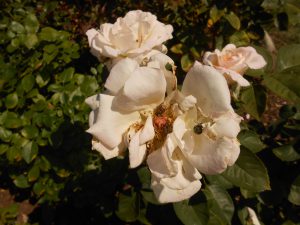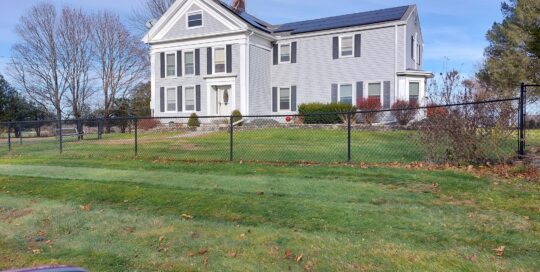Controlling Summer Pests on Roses
Views: 6581

We wait all year for summer. It is a favorite time of year. Unfortunately, though, summer brings pests we like to forget about as we browse through our garden pictures each winter. July’s heat brings them out.
Japanese Beetles in Roses
First, in our part of the country, are the dreaded Japanese Beetles. Their larval stage attacks plant roots, especially lawns, during the whole growing season.
I find Japanese Beetles every spring while I’m digging in the soil. These are the dreaded white grubs which I squish with gloved fingers while I’m planting. These grubs feed until they are ready to go into the pupal stage (cocoon-like) and then when the sun bakes the soil, they emerge as adult beetles in the beginning of July.
It’s not unusual to have a rose blossom completely covered with 30 or 40 beetles, all chewing and mating at the same time. I hate going outside when they erupt from the soil, because there can be so many of them on a hot morning that their legs get caught in my hair and on my clothes. I think these pests are just disgusting. Not only do they devour our roses, but they chew tender foliage into lace.
Killing Japanese Beetles
I happily sprayed the Japanese Beetles last Sunday with Ortho’s Insect and Disease Control which has a pretty good residual. There are now dead beetles all over the ground, but at least I got a lot of them before they were able to lay their eggs in the soil.
I always keep a couple of jars of soapy water in the gardens for control between sprayings. Hold the jar under the beetles on the blooms and give them a poke. They will drop straight down into the jar and drown. (YAY!) Some folks prefer to control these pests in the larval stage, using granular merit (imidicloprid) in the spring. Some beetles will make it through, nevertheless.
This year, I have purchased Milky Spore Disease and will apply it before the end of July, when the newly-laid eggs hatch. They are super hungry at this early stage, and will have to ingest a spore or two. The spores will multiply inside the grub and the little worm will eventually explode, spreading more spores about. Application is a spoonful every four square feet. I figure I need the exercise, anyway, and I’m looking forward to putting it down. Bye-bye beetles and other pests! And it lasts for at least a couple decades.
Other Pests: Rose Midges and Thrips
The next major pests are rose midges and thrips. These two nasties are particularly tough to get rid of. They are too small for me to see, but I can spot their damage from twenty paces.
Ever been at the beach on a hot and sultry day and get nipped by No-See-‘Ums? These are also midges, but they suck people sap instead of rose sap. The adult midges emerge from their pupal stage in the top inch of soil, mate, and then the female deposits her eggs on the growing tips of our roses. Overnight, the tiny maggots emerge and suck the life out of the new growth and it looks like it’s been hit with a cigarette lighter…burned! The maggots drop to the ground, crawl down an inch, and become a pupa. The whole cycle starts all over again.
Thrips have a similar lifestyle (they also pupate shallowly beneath the plant), but they go directly for our blooms. Thrips fly clumsily (they look like a miniscule mosquito) and get caught in the puffs of hot summer breezes to arrive on our roses. Once they have established themselves in our gardens, the female will deposit her eggs via her ovipositor into the base of a bud. When the rose bud opens, the damage is already happening. The edges of the petals look burned, and the whole bloom will look streaked and dirty.
There can be several stages of thrips in the blossom doing their damage…from newly-hatched to adult, their rasping mouthparts will suck the life right out of the blossoms. I had one especially hot summer that I was so infested with them that I cut off and destroyed all the rosebuds just to break the cycle!
How to Identify Thrips
Identifying thrips in your roses is easy: take a lungful of your own air and breathe it directly into the bloom. you will see what looks like tiny little threads wiggling around. Some folks use Spinosad to control thrips, some use Avid, a miticide. Others will try to control them and the midges by covering the ground under the plants with plastic for a couple of weeks to break their life cycle. Some will use five inches of mulch (I like this idea) to prevent the emerging adults from reaching the surface. And some will use a drench of imidicloprid (Merit) all around their roses to nail them in the ground. If you choose to use chemical drench control, though, be sure to use a lot of water to be sure to get the product down into the root zone where it needs to be to be effective. Merit becomes chemically bound-up in organics, so it’s a good idea to pull back your mulch before you dump your drench.
I just heard that midges and maybe thrips, too, are attracted to the color blue. You can take STP and an old paint brush and coat a blue Solo plastic cup with the thick goo. Then, mount it on a bamboo stake in the garden. They are drawn to it, they stick, and it’s curtains for the little buggers! I’ll let you know how that one works!
Meet Marci Martin
Marci Martin has loved roses for as long as she can remember. From the time she was a little girl, she was fascinated with how…
Marci's Recent Posts

Roses and Friends at Race Point Lighthouse








